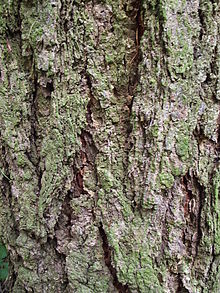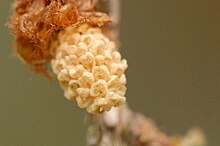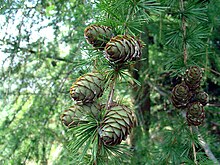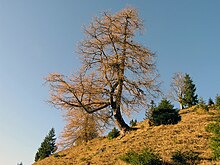European larch
| European larch | ||||||||||||
|---|---|---|---|---|---|---|---|---|---|---|---|---|
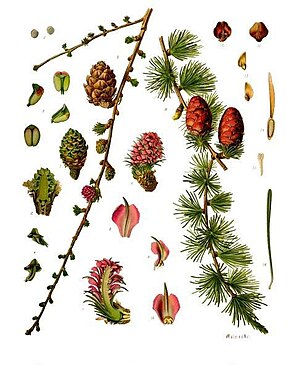
European larch ( Larix decidua ), illustration |
||||||||||||
| Systematics | ||||||||||||
|
||||||||||||
| Scientific name | ||||||||||||
| Larix decidua | ||||||||||||
| Mill. |
The European larch ( Larix decidua ) is a species of the larch ( Larix ) genus in the pine family (Pinaceae). Its natural distribution areas are mainly the Alps and some areas in the Carpathian Mountains. It probably survived the last Ice Age in the Carpathian Mountains . For economic reasons, the European larch has been grown for centuries far outside of its natural range in significantly warmer regions , especially in Central European low mountain ranges .
The global warming makes it there much to create.
It was Tree of the Year in Austria in 2002 and Germany in 2012.
description

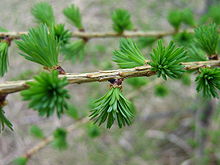

Habitus
The European larch is a deciduous tree that reaches heights of 54 meters and trunk diameters ( breast height diameter ) of 1.5 to 2 m. The treetop is irregularly pyramidal to slender-conical. The cylindrical to almost spherical short shoots have rings made from remnants of scales.
European larches reach an age of no more than 600 years, but some older specimens have also been found. In Blitzingen in the Valais , a 30-meter-high tree with 686 annual rings (at a trunk height of 7 meters) was felled, which must have germinated around 1280. In the Ulten Valley in South Tyrol there are the three Url larch trees , which germinated around the year 1150.
root
The typical root system of the larch is the heart root system. Due to its strong root energy, it goes deep into soils rich in skeletons (gravel and stone). This leads to numerous curvatures of the roots. If it reaches fissures filled with fine earth, it goes down to a depth of 2 m. Root injuries resinify quickly. There is therefore a low risk of root rot. The larch can be introduced into the soil over limestone as well as over quartz and silicate rock .
bark
The bark of the long shoots is initially light yellow to light grayish yellow and turns gray or blackish in the second or third year. The bark is smooth and green to gray-brown when young and relatively soon becomes 1 to 10 centimeters thick, deeply furrowed, externally gray-brown, irregularly scaly bark with red-brown furrows.
Needles
Many of the needles are on short shoots and individually on long shoots. The leaf cushions are densely hairy downy yellow. The needles are between 10 and 30 mm long and 0.5 to 1 mm wide. They have a narrow, mostly flattened shape and are blunt or only slightly pointed at the front, sometimes they are slightly keeled on the upper side and clearly keeled on the lower side. They are very flexible and soft. At the time of budding, these are light green, later darken and are on short shoots of 20 to 40 pieces in rosettes arranged clusters. On the long shoots they are individually arranged in a screw-like manner and are usually pointed. In autumn they turn golden yellow and fall off. The leaf bases remain, which gives the bare branch a rough appearance. The needles are usually one year old, rarely wintering up to four years. Shedding the needles in winter reduces evaporation and prevents the tree from drying out. In the soft needles of the larch, the stomata are not sunk and are protected by a layer of wax , as in other conifers .
blossoms
The larch reaches outdoor stand with about 15 to 20 years, the portfolio of 30 to 40 years, the puberty . The larch is single-sexed ( monoecious ), so there are male and female flowers on one individual. The flowers are formed before the needles on the at least two-year-old short or three-year long shoots .
The male flowers are egg-shaped, 5 to 10 millimeters long, sulfur-yellow and are located on short, needless shoots. The female flowers, which are usually upright on three-year-old needled short shoots, are about 10 to 20 mm in size and ovate to ovate-elongated. During the flowering period, the female flowers are pink to dark red or purple in color, they turn green in autumn with pink scale edges.
Ripe cones and seeds
The ripe, upright cones are light brown, egg-shaped and are 2.5 to 4 cm long and 1.5 to 2 cm wide. The round, loosely lying seed scales have fine stripes, have a brownish hair and are not or only minimally curved outwards at the upper edge (in contrast to the Japanese larch , whose cone scales are strongly curved outwards at the top). The seed scales lying close to maturity are ovate or almost circular with a length of 0.8-1.5 cm and a width of 0.7 to 1.3 cm.
The shiny, dark-brownish-gray seeds , which ripen in the next spring, are ovoid-wedge-shaped or triangular-ovoid with a length of 4 mm and a width of 2.5 mm. They have light brown, egg-shaped wings. After the seeds fly out, the cones fade, which only fall to the ground after 10 years with the branch (totaster holder). The seeds ripen from September to November.
Chromosome number
The number of chromosomes is 2n = 24.
confusion
The Japanese larch can be confused with the European larch, but it differs significantly in its reddish annual shoots, rolled up cone scales and the wider, more expansive growth. The hybrid larch ( Larix eurolepis ) also grown in Central Europe is a cross between the European and Japanese larch. It lies between the two types in appearance and is also easy to confuse.
ecology
The European larch is the only deciduous, winter-bare conifer native to Europe . In order to avoid damage caused by frost drought on sunny winter days, the larch loses its leaves in autumn, as is otherwise common with deciduous trees .
As root fungi z. B. the larch boletus and the fly agaric in question. Mycorrhizal fungi often thrive at the foot of the larch, such as the golden boletus (yellow larch boletus), the hollow foot boletus , the rarer gray larch boletus , the rust-red larch boletus and some milklings .
It is windy of the "immovable type". The male cones are yellow and directed downwards; the female cones are red and face upwards. The pollen has no air sacs. During pollination it is held in place by a scar-like structure at the tip of the ovule ( micropyle ) and then shrunk to the ovule. One drop of pollination is missing. Pollination with pollen from the same individual when there is no wind is prevented by the fact that the pollen sacs that open on their underside are directed upwards by hanging down the male inflorescences. Start of flowering at 15 to 60 years.
The seed cones ripen in the first year and stay on the tree; they are egg-shaped and their scales are directed forward. The seeds are winged and spread like rotating fliers . In addition, processing spread by birds and water spreading takes place. The seeds ripen from October to November.
Systematics
The first publication of Larix decidua was made in 1754 by Philip Miller in The Gardener's Dictionary ... Abridged ... , fourth edition, no second. Synonyms for Larix decidua Mill. Are: Pinus larix L. , Abies Larix (L.) J. St. Hil. , Picea larix (L.) Peterm.
There are several varieties:
- Common European larch ( Larix decidua Mill. Var. Decidua , Syn .: Larix decidua subsp. Sudetica (Domin) Domin , Larix sudetica Domin , Larix europaea DC. ): The common European larch s. st. is the most widespread and large areas (usage and ecology) in this article refer to this variety. It occurs in the Alps, the Sudetes and the western Carpathians.
- Carpathian larch ( Larix decidua var. Carpatica Domin , Syn .: Larix carpatica Domin ): It occurs in the eastern and southern Carpathians.
- Polish larch ( Larix decidua . Var polonica .. (Racib ex Wóycicki) Ostenf & Syrach , Syn .: Larix polonica Racib Wóycicki ex. , Larix decidua subsp. Polonica (Racib ex Wóycicki) Domin. ): The Polish larch has a disjoint Area in the northern flatlands of Poland . The cones are between 2 and 3 cm in size. The bark of the young twigs is light yellow to whitish.
Occurrence
The larch forms forests, especially in subcontinental climates, together with the common spruce ( Picea abies ), especially on steep slopes and on log locations. It also occurs in admixture in pine and spirit forests . The species reaches the upper tree line in the Central and Eastern Alps together with the stone pine ( Pinus cembra ). The larches grow here up to an altitude of 2500 m above sea level.
In afforestations outside of its natural range, the European larch often occurs in mixed stands with the common beech .
The larch is a decidedly light tree of the upper montane to subalpine altitude . Together with the stone pine , it forms the Swiss stone pine -larch forest, the typical forest form of the upper tree line in extreme high mountain areas. Mountain forests, which consist of pure larch stands, can be found today mainly at the foot of the slopes and on easily accessible slopes exposed to radiation. This current distribution picture of pure larch stands goes back to a large extent to the centuries-long influence of the mountain forests by humans. Without human intervention, the more shade-tolerant stone pine would have gradually displaced the light-hungry larch via the natural forest succession. However, where mountain areas offered themselves for pasture use, humans have deliberately cut out the stone pines and spruces. In this way, light-flooded forests were created, which, like the oak forests of the lower elevations used for acorn fattening , are suitable for pasture farming. This species shift in the mountain forest in favor of the larch was also supported by the fact that the stone pine is much more severely damaged by browsing and repression . Because of their thick, cork-like bark, larches were more resistant to the forest fires that used to occur very frequently.
The alpine pasture economy is only of secondary importance today; This means that the Swiss stone pine would have to regain a larger share in the mountain forest through natural forest succession. In fact, in many regions, Swiss stone pines now form a second layer of trees under the light canopy of the larches. Studies by Friedrich-Karl Holtmeier show, however, that the gray larch moth has created a new ecosystem with a previously unavailable stability that prevents the Swiss stone pine from dominating. The gray larch moth shows a mass multiplication at several year intervals in which the larches are eaten bare. If the larch caterpillars are no longer available, they switch to the stone pines and destroy their needles as well. While larches do not usually die when they are attacked by larch buds, stone pines suffer very long-term. Weakened stone pines are then susceptible to attack by other pests such as the common pine weevil , the Swiss stone pine wool aphid or the bark beetle , and then die or develop into stunted trees.
The larch can withstand temperatures of -40 ° C as well as the heat of summer. Your nutritional requirements are low to medium; however, like every forest tree, it prefers loamy soils. It is only found on very nutrient-poor sands. The water requirements are not particularly high; it colonizes fresh to moderately fresh, but also dry locations. Even on Kalkrendzinen it gets to an adequate water supply when the fissures are durchwurzelbar.
Diseases and pests
When grown in lower, oceanic locations, it is susceptible to larch crayfish ( Lachnellula willkommii ). In addition to its natural distribution, the larch can also suffer from so-called "larch degeneration". This is caused by lower bacteria and manifests itself in needle yellowing, shoot upsets and witch brooms . Other fungal diseases are:
- Shoot dieback ( Brunchorstia laricina )
- Gray mold rot ( Botrytis cinerea )
- Larch chute ( Hypodermella laricis )
- Damping-off ( Moniliopsis klebahni )
The most important pest in the alpine region is the gray larch moth , which starts out from the larch and also damages the stone pine . Other insect pests are:
- Large larch bark beetle ( Ips cembrae )
- Larch buck ( Tetropium gabrieli )
- Larch leaf miner ( Coleophora laricella Hb.)
- Larch bladder foot ( Taeniothrips laricivorus )
- Larch bud gall mosquito ( Dasyneura laricis )
- Larch needle aphid ( Adelges geniculatus )
- Larch sawfly ( Cephalica lariciphila )
- Great larch sawfly ( Pristiphora erichsonii )
- Lesser larch sawfly ( Pristiphora laricis )
- Yellow larch sawfly ( Pristiphora wesmaeli )
So far, two quarantine pathogens have appeared in Europe :
- Pine wood nematode ( Bursaphelenchus xylophilus )
- The fungus-like microorganism Phytophthora ramorum
Importance as a fodder plant (selection)
The caterpillars of the following butterfly species depend on the plant as a food source.
- Pine hawk ( Hyloicus pinastri )
- Pine moth ( Bupalus piniaria )
- Pine processionary moth ( Thaumetopoea pityocampa )
- Monastery woman ( Panthea coenobita )
- Nun ( Lymantria monacha )
- Larch leafminer ( Colephora laricella )
- Gray larch moth ( Zeiraphera diniana )
use
Use as an ornamental plant
The cultivar 'Little Boggle' is grown as a mini shrub in the garden or as a bonsai .
Trees planted in large cities are usually very stunted because they cannot cope with the pollution caused by smoke gases. The needles that fall off in autumn lead to an improvement in the soil after a short time, which then gives the more demanding species such as Norway spruce ( Picea abies ) and Swiss stone pine ( Pinus cembra ) the opportunity to settle.
The forestry rotation period is 100 to 140 years.
Use as a medicinal plant
So-called larch turpentine, the balm obtained by drilling into the trunks, is used as a medicinal drug . (This turpentine was also known as gloriet and loriet in the past ).
Active ingredients: essential oil with pinene , borneol and 3-carene ; Resin acids , especially laricinoleic acid .
Application: Larch turpentine has the same effect as ordinary turpentine from Pinus pinaster , namely irritating to the skin and antiseptic ; it is rarely used. It is used in the form of ointments, emulsions, plasters or bath additives e.g. B. against boils , abscesses and rheumatic complaints, in the form of suitable inhalations also for respiratory diseases.
More common, however, is the technical use for paints and adhesives.
Use as a food plant
The light green, young and still dense shoot tips of Larix decidua taste sour and tart at the same time (something like resinous lemon) and are suitable as a sour addition to a carrot vegetable as well as for a cream cheese preparation or as an addition to dessert.
Wood
→ Main article: larch wood
Larch wood is mainly used as construction and furniture wood, much less often it is used as firewood. The European larch is economically the most important in Eurasia compared to other species, in addition there is the Japanese larch from the Japanese island of Honshū, which is partly also grown in Europe, and the hybrid larch ( Larix eurolepis ) grown from the European and Japanese larch .
Larch wood is the heaviest and hardest wood of the European coniferous timber and is only surpassed by the rarely used yew . It is used as construction timber for roof structures, wall and ceiling constructions, in interior construction for almost all wood uses, including stairs, railings, wall cladding, doors, parquet and plank floors as well as in exterior areas for house doors, garage doors, windows, facade cladding, frames and parapets as well as for large panels used. In addition, there are many special uses due to the special properties of larch wood in earthworks, hydraulic engineering and bridge construction, in boat building and for numerous other applications.
In the past, the bark was used for tanning because of the tannins it contained ; it turns leather almost black.
The energetic use of larch wood plays a comparatively minor role. Larch wood has a calorific value of 4.4 kWh / kg or 1700 kWh / rm and is therefore comparable to pine and Douglas fir . Like most types of wood, it is mainly used in private house fires in the form of split logs . Industrial waste ( wood chips ) and the like are used as wood pellets . a. also offered from larch wood production in the form of mixed pellets.
ingredients
The best turpentine is the Venetian or larch turpentine (Latin: Terebinthina veneta ). It is obtained from the still fresh resin effluent from the European larch and consists primarily of the monoterpenes 2- pinene and 3-carene .
Valuable turpentine oil can be obtained from larch turpentine by steam distillation and cleaning .
Coniferin , the main glycoside of the softwood family , can also be obtained from the European larch. It is the storage and transport form of coniferyl alcohol , which is used for the biosynthesis of lignin and numerous phytoalexins .
Culture
In various parts of Germany on April 30th, a "witch's rattle" is hung on doors and windows to drive away the bad witches.
Since the time of Emperor Augustus, the Romans have referred to the European larch as Larix - a word used by the Gallic Alpine population. This Gallic-Latin name lives on in the Italian Larice , in the French- dialectal Larze and in the Rhaeto-Romanic “Larsch”. The localities Laret (GR) and Latsch (GR) have a name derived from the Latin name Larix .
More photos
The photos also show a characteristic example of gravitropism (see also plant movements ): The female cones align themselves against the gravitational pull (negative gravitropism), while the male cones grow in the direction of the gravitational pull (positive gravitropism).
literature
- Christopher J. Earle: Information on Larix decidua at The Gymnosperm Database , 2007. (Section description and systematics)
- Liguo Fu, Nan Li, Thomas S. Elias & Robert R. Mill: Pinaceae : Larix decidua , p. 36 - Online , Wu Zheng-yi, Peter H. Raven (Eds.): Flora of China . Volume 4: Cycadaceae through Fagaceae . Science Press / Missouri Botanical Garden Press, Beijing / St. Louis 1999, ISBN 0-915279-70-3 (English).
- Wolfgang Adler, Karl Oswald, Raimund Fischer: Excursion flora of Austria . Ed .: Manfred A. Fischer. Eugen Ulmer, Stuttgart / Vienna 1994, ISBN 3-8001-3461-6 .
- Ulrich Hecker: FSVO nature guide trees and bushes . BLV , Munich 2001, ISBN 3-405-14738-7
- Heiko Bellmann : The new Kosmos butterfly guide. Butterflies, caterpillars and forage plants. 2nd Edition. Franckh-Kosmos, Stuttgart 2009, ISBN 978-3-440-11965-5 .
- Ingrid and Peter Schönfelder : The new manual of medicinal plants , Franckh-Kosmos Verlagsgesellschaft, 2011, ISBN 3-440-09387-5
Individual evidence
- ↑ a b LWF / Wolfgang Falk, Ute Bachmann-Gigl and Christian Kölling (2012): The European Larch in Climate Change - LWF Knowledge 69 (pdf)
- ↑ Federal Ministry of Agriculture, Forestry, Environment and Water Management : Tree of the Year 2002 (accessed on December 3, 2015)
- ↑ Tree of the Year 2012
- ↑ a b c d e f g Liguo Fu, Nan Li, Thomas S. Elias & Robert R. Mill: Pinaceae : Larix decidua , p. 36 - Online , Wu Zheng-yi, Peter H. Raven (ed.): Flora of China . Volume 4: Cycadaceae through Fagaceae . Science Press / Missouri Botanical Garden Press, Beijing / St. Louis 1999, ISBN 0-915279-70-3 (English).
- ^ Tropicos. [1]
- ^ Larix decidua at Tropicos.org. Missouri Botanical Garden, St. Louis
- ↑ a b Rafaël Govaerts (ed.): Larix. In: World Checklist of Selected Plant Families (WCSP) - The Board of Trustees of the Royal Botanic Gardens, Kew . Retrieved April 12, 2019.
- ↑ a b c Schröder Thomas, Schumacher Jörg, Bräsicke Nadine (2012): Harmful organisms on European larch. AFZ-DerWald, 10/2012, pp. 22-26. Available online at waldwissen.net ( Memento of the original dated August 4, 2012 in the Internet Archive ) Info: The archive link was inserted automatically and has not yet been checked. Please check the original and archive link according to the instructions and then remove this notice.
- ^ Friedrich-Karl Holtmeier: Animal in the landscape - influence and ecological significance . Ulmer, Stuttgart 2002, ISBN 3-8001-2783-0 (Holtmeier goes into detail in his book on the interrelationship between larch, gray larch moth and Swiss stone pine.)
- ↑ Jürgen Martin: The 'Ulmer Wundarznei'. Introduction - Text - Glossary on a monument to German specialist prose from the 15th century. Königshausen & Neumann, Würzburg 1991 (= Würzburg medical historical research. Volume 52), ISBN 3-88479-801-4 (also medical dissertation Würzburg 1990), p. 148.
- ↑ Meret Bissegger. My wild vegetable kitchen. Photos by Hans-Peter Siffert. Aarau and Munich: AT Verlag, 3rd edition 2011, ISBN 978-3-03800-552-0 , pp. 31-34.
- ↑ D. Grosser, W. Teetz: Lärche . In: Local timber (loose-leaf collection) . Information service wood, wood sales fund - sales promotion fund of the German forest and wood industry, 1998, ISSN 0446-2114 .
Web links
- European larch. In: FloraWeb.de.
- European larch . In: BiolFlor, the database of biological-ecological characteristics of the flora of Germany.
- Profile and distribution map for Bavaria . In: Botanical Information Hub of Bavaria .
- Distribution in Switzerland [2]
- Thomas Meyer: Data sheet with identification key and photos at Flora-de: Flora von Deutschland (old name of the website: Flowers in Swabia )
- Profile at baumkunde.de .
- Profile at gehoelze.ch . (PDF; 147 kB)
- Tree species portrait at Waldwissen.net .
- photos
- Larix decidua in the endangered Red List species the IUCN 2006. Posted by: Conifer Specialist Group, 1998. Retrieved on 12 May, 2006.
